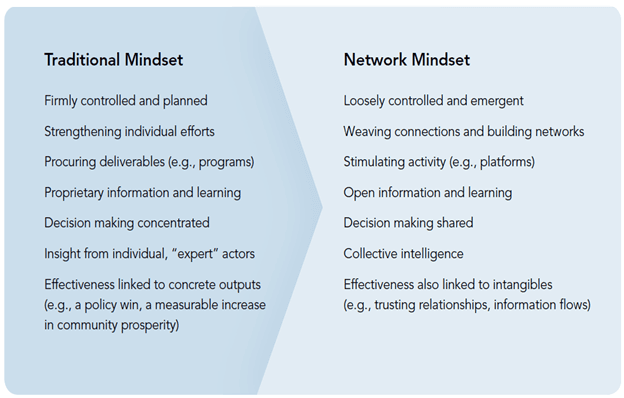Today, we’re more connected than ever. Facebook, for example, has more than 800 million active users (that’s more than 1 in every 9 people in the world), and political and social movements like Occupy Wall Street and the Arab Spring have demonstrated the power of these connections in creating social change.
For change makers, tapping the power of social connections, sharing leadership and power, and embracing openness and transparency are critical to success, and will require working with a network mindset.
Last week, more than 140 funders from foundations large and small throughout North America gathered at a conference hosted by Grantmakers for Effective Organizations and Monitor Institute to explore what it means to work with a network mindset and grow social impact in a networked world. For organizations that are funding social change, the message was clear: Maximizing impact in an era of interdependence means that funders need to act as conveners, champions, and matchmakers that connect people, ideas, and resources—in addition to getting money out the door. This means doing more than investing in discrete programs and individual organizations. It means catalyzing networks.
Throughout the conference, participants explored the interface between the traditional and network mindset, and discussed what it might take for funders to default toward a more open, shared model of leadership (see the chart below). For example, the Robert Wood Johnson Foundation in Princeton, N.J., is working on stimulating aligned social action through its open platform for connecting activists at PreventObesity.net.
Are you enjoying this article? Read more like this, plus SSIR's full archive of content, when you subscribe.

A network mindset does not replace traditional approaches. Instead, as Lisa Gansky, serial entrepreneur and author of The Mesh: Why the Future of Business is Sharing, told us: In a network environment, creating both the conditions for serendipitous connections and possibilities and a laser-like focus will be essential. Leaders need to artfully combine bottom-up and top-down sensibilities.
Gabriel Kasper from Monitor Institute interviewed conference attendees about what they were taking away and produced this video of the “top ten aha moments.” We asked participants to vote for the most critical insight among these ten. The three top vote getters:
#3 The value of values. Healthy networks have clearly articulated values that underpin shared aspirations, while linking across the interests and concerns of network members’ diverse reasons for participation.
#2 The importance of trust and relationships. Working in concert with others and inspiring people to connect and align their efforts can only be done with authentic and reciprocal relationships in place.
#1 A shift in identity from grantmaker to changemaker. Catalyzing networks and widespread social action requires boldly exercising leadership and channeling assets like convening power, the ability to spread ideas, and engaging influential people—in addition to money.
What do you think is most essential for funders to keep in mind when catalyzing networks for social change? You can share your vote in the comments section below.
For more on this topic, you can read the new Monitor Institute and GEO publication Catalyzing Networks for Social Change: A Funder’s Guide, an effort to create a road map for individuals and foundations that are catalyzing networks to build impact.
Support SSIR’s coverage of cross-sector solutions to global challenges.
Help us further the reach of innovative ideas. Donate today.
Read more stories by Diana Scearce & Lori Bartczak.

